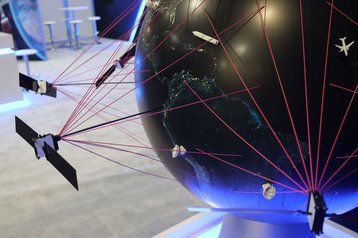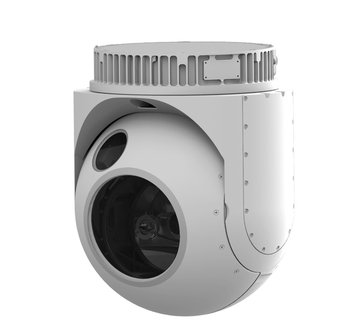As the heavens fill with man-made celestial bodies, there exists an opportunity to rewire the world. Except, this time, we won’t need wires.
As Google became an intrinsic part of every Internet journey, the company faced an enviable problem - it was running out of fresh Internet users to monetize. Flush with cash and ambition, the company kicked off multiple projects to connect the world.
Some, like Google Fiber, have stalled. Others, like ground-based free space optics Project Taara, are still ongoing. Yet more, like a plan to connect the world by balloon, came crashing back to earth and were shuttered.
But from their ashes, a new company hopes to help finish the job.
Last year, Google spun out the new startup Aalyria to build on two technologies that will help connect the world. To understand more, we spoke to the CTOs of each effort.
This feature appeared in Issue 50 of the DCD Magazine. Read it for free today.
A planetary SDN
As we seek to connect billions more people, and increase coverage for the already connected, the telecoms industry will have to look beyond cell towers and fiber to moving assets in the skies.
"Altitude allows you to trade for population density," Spacetime CTO Brian Barritt explained. "The lower a transmitter is, the more the megabits per second, which is good for tighter population densities. You raise that transmission higher, you cover more area, but it's the same megabits per second - so now it supports a lower population density.
"Population densities are clumpy, irregular, and they span five orders of magnitude across the Earth's surface. So I think it lends itself to a world that will have five orders of magnitude of altitude. Think of towers, high-altitude platform stations (HAPS), Low Earth Orbit (LEO), Medium Earth Orbit (MEO), and Geostationary Earth Orbit (GEO).
“At some point, we will need all of the above.”
Routing between all of these layers of moving objects introduces an entirely new level of complexity, especially when you add in providing connectivity to airplanes and ships.
“The whole idea behind Spacetime was ‘what if the network fabric didn't exclusively include just static physical links? What if it was the set of all possible links that can exist across space and time?”
Built out of the Minkowski routing system for Loon, Aalyria envisions a network of satellites and other moving objects coming in and out of connectivity with each other, ground stations, and user terminals. The network is no longer a fixed asset, but one that changes both in location and over time.
“They're all changing their position materially to the network. The possibilities can be massive, a giant webscale graph of tens of millions of possible pairings,” Barritt said.
Along with trying to work out the best route, Spacetime can configure the pointing and steering of steerable antennas as well as configure radios and channels to create alternative physical links. “So, out of the set of all the possible things that could exist in the universe of the network, which physical links should be brought into existence at what time interval?”
To work this all out is “very computationally intensive,” Barritt said. The company is constantly calculating the current and potential routes of its customers, tweaking if the weather forecast predicts rain in regions where it would otherwise rely on frequencies that are sensitive to precipitation.
“We model the orbital properties of the satellite, calculate the parameters of motion, and do wireless signal propagation modeling across different atmospheres,” Barritt said.
Where possible, it tries to peer into the future, helping pre-schedule handovers and routing changes. “But when you have an unexpected thing, like someone suddenly asks for a new route between two nodes or suddenly removes a satellite from the network, the solving engine doesn’t have to model everything, just the [new element].”
For satellites, where orbital routes are usually pretty predictable, the system can plan far in advance. When trying to connect to a human-piloted aircraft, it can see a couple of seconds ahead - “just enough time before the aircraft’s wingtip breaks the beam, we can light up the new path.”
This, Barritt believes, will help lead to “a fundamental shift from a network, from a geostationary network to one where the infrastructure itself is moving.”
But, to do that, will also require new hardware capable of sending large quantities of data across vast distances.
Seeing the light
Aalyria’s second grand project predates its time at Google, dating back to the turn of the century. “As far back as 2002, Lawrence Livermore Labs were flying ER-2s [high-altitude planes] with ground-to-air connectivity at 20 gigabits,” Tightbeam CTO Nathan Wolfe said.
“They spun out of Lawrence Livermore and became a group called Sierra Photonics and, ultimately, were acquired by Google [in 2014].”
The company realized that while what would become Spacetime would help connect assets like Loon intelligently “a brain without connectivity solution isn't necessarily quite as useful,” Wolfe said.
“We had to move bytes from one point to the other, at Google-scale speeds. That's a very loaded word - because, until you work at Google, you really just don't understand what scale is.”
What the team at Livermore, and then Google, were working on was free-space optics - essentially lasers beamed through the surrounding medium, rather than something like fiber.
Companies and researchers have long seen free-space optics as a way to dramatically improve global connectivity, but most approaches have relied on non-coherent light - including Google’s ongoing Project Taara - with data encoded on the amplitude of the light source sending the signal.
This is where Aalyria thinks it could change the game, with a coherent light system where data is encoded on the phase. “With noncoherent, you’re counting on a lot of amplitude for one and very little amplitude for zero, but the atmosphere likes to play with it - just look at the stars and see them twinkle,” Wolfe said.
With coherent light, Aalyria’s Tightbeam system is “capable of running 400 Gig channels today - if we need it to, we can run four channels at any given time. We can go four 100 Gig channels, or we can go one 400. Or, ultimately, we could go four 400 Gig channels, which would be a 1.6 terabytes system full duplex - marketing would call that a 3.2 terabytes.”
The company currently operates a test link between its facility in Livermore and Mount Diablo. “That's a 60-kilometer roundtrip link and at night we close that link on about 125 milliwatts,” Wolfe said. “To put that into context, the nightlight in your hallway is typically a two-watt light, so about 1/16 of the power of your nightlight puts out to close 100 gigabit, packet error rate near zero.”
As the name Tightbeam suggests, free space optics is also a straight-line connection. Unlike radio frequency (RF), which sends data across a wide arc, free-space is both more efficient and harder to intercept.
The downside is that, at least for now, it’s a one-to-one system, with one Tightbeam aperture talking to another aperture at any given moment. “If you want to go from an airplane to an airplane, you have to have one aperture to talk to the ground and another aperture to talk to something else,” Wolfe said. ”There are ways to do phased array and multi-aperture approaches, but those don't tend to work with coherent light.”
However, with some of the project’s roots in Loon, Wolfe noted that the apertures had to be developed with the possibility of “crashing on a farm in Kazakhstan where you can’t get it back, so it had to be at a cost point where we didn’t care.”
While at Google, the team “contemplated testing it inside the data center,” Wolfe said. “For example, to connect different data halls with multi-terabit fiber takes time.
“Or inter-building connectivity or connectivity to the metro area. Maybe not always as primary, but it's certainly a reasonable backup to have in place.”
The company may still explore that market, but is primarily focused on a broader goal: “We'd love to break the economics of connectivity, especially ground-to-space,” Wolfe said.
“If you look at the architecture of ground stations today, to get 60 gigabits to a GEO or MEO orbit requires three or four different ground stations that are located tens or hundreds of kilometers apart… Those ground stations cost about $20 million to build plus 10 percent of the cost annually to maintain.
“You could eliminate the majority of them and go to optical terminus, and increase your data rate, potentially up into the terabit range.”
The company hopes to do what SpaceX did for getting satellites into space for connecting those satellites to ground - announcing a deal with satellite fleet operator Intelsat to create "subsea cables in space," capable of hundreds of gigabits per second.
With new LEO mega-constellations like Starlink, “you could put billions of more people onto the Internet, but the problem is you've got to be able to feed that constellation,” Wolfe said.
“Right now, those constellations are limited by the RF connectivity that the ground stations can deliver those constellations, we're talking about lifting that connectivity ceiling. Imagine if you could get a gigabit into space - what would that do to global connectivity?"



